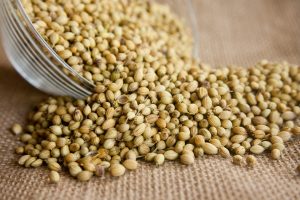 Coriander (Cilantro) is an extremely popular spice plant of the celery species, reminiscent of parsley. Due to its healthy properties, coriander is also used in natural medicine. What are the coriander leaves and seeds helping? What is their nutritional value?
Coriander (Cilantro) is an extremely popular spice plant of the celery species, reminiscent of parsley. Due to its healthy properties, coriander is also used in natural medicine. What are the coriander leaves and seeds helping? What is their nutritional value?
Coriander leaves – properties and nutritional values
Coriander, known primarily as an interesting addition to take, has gained widespread use in natural medicine. Fresh coriander leaves are a wealth of vitamins A and C, natural antioxidants, fight against free radicals, responsible inter alia for accelerating the rate of aging of body cells. They also contain B vitamins and K vitamin, which is responsible for proper blood coagulation. Coriander provides minerals: iron, magnesium, zinc, potassium and calcium, and thus a number of elements supporting the numerous functions of the body.
The herb has beneficial effects on the cardiovascular system and maintains the proper level of cholesterol in the blood, so it is valuable in the prevention of atherosclerosis or heart disease. Supports appetite and protects against colon cancer. The healing effect of coriander has been appreciated because it has a powerful cleansing effect on the body. Detoxifying properties of coriander are with all types of diets supporting detoxification of the body and as support for the proper functioning of the stomach, intestines and liver. Coriander also stimulates lactation in women who are breastfeeding.
How do coriander seeds work?
Coriander seeds are a very good source of organic compounds: linalool, geraniol, borneol with antiradical activity and fatty acids, including omega-6. The healing properties of coriander seeds can be used after brewing them with water, often with the addition of honey and lemon. In this form, the infusion of coriander seeds helps with digestive problems and bloating.
Coriander seeds contain fiber to improve digestion. Grated coriander with the addition of linseed oil can be used as a dressing for burns. Coriander also works antifungal, it is helpful in the treatment of ulcers. As a herb plant it has been used in the treatment of haemorrhoids, in rheumatic pains and is used in the production of laxatives.
Valuable are also the health properties of coriander seed oil, which is used in various pain conditions, because it has anti-inflammatory effects. It is also used in the cosmetics industry for the production of flavoring soaps, creams and perfumes.
Keep moderation when using coriander. Spice is not recommended for pregnant women and children under 12 years of age. Excessive consumption of coriander fruit can cause nausea and headache. In turn, coriander oil causes skin hypersensitivity to solar radiation.
Kolendra in the kitchen – taste and application
Coriander is valued in the kitchen for its intense expressive aroma and specific aniseed and oriental flavor. Is a spice that appears very often in Asian (Indian, Thai) cuisine.
The taste of coriander in the form of seeds is different from the taste of the leaves – delicate, sweet, harmonizes with the citrus scent. Grains are used as an addition to sweet dishes, for example gingerbread, cakes with spices. To bring out a strong aroma, heat the beans and then grind them in a mortar to free the essential oils.
The taste properties of coriander are best preserved if it is added to dishes fresh. Coriander seeds are best purchased in a whole and grinded, powdered coriander definitely loses its fragrance value much faster. Drying coriander herb and freezing definitely weakens the culinary properties.
Coriander should be added to take place immediately before serving or just before the end of cooking or frying. The leaves added at the beginning of cooking boil the intensity of taste and aroma.
What is the use of coriander?
Aromatic green leaves, root and ground coriander seeds are used to enrich the taste and enhance the aroma of products and dishes. What to add coriander to?
- Coriander is particularly good for the taste of lamb, pork ham, poultry dishes. It also works well as an addition to fish and seafood.
- It is a great addition to curry with chicken, goulash and vegetable and meat stuffing.
- The coriander fruit can be used for marinating meat, mushrooms and vegetables.
- Vegetable soups perfectly complement the addition of fresh coriander leaves.
Fresh vegetables and vegetable salads with the addition of coriander gain a unique flavor and aroma. - Coriander enriches all dishes based on rice, couscous, and is suitable for flavoring falafels.
- It is a component of curry, a mixture of garam masala and Arabic soils, it can also be found in mustard and in various types of marinades.
- Fresh coriander added to dishes with a high content of meat and legumes facilitates their digestion.
Coriander is perfectly harmonized with the addition of lime, ginger, garlic, lemon grass, mint, cumin and basil. Dried coriander leaves can be added to dishes from beans, lentils, cabbage, eggplant. It is also suitable for sprinkling pumpkin soup, carrot cream, onion, seasoning vegetable dips. Fits sauces with tomato and chili, garlic sauce and natural yoghurt.
Picture Credit: PDPics
